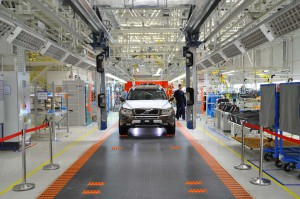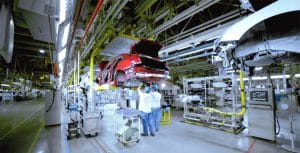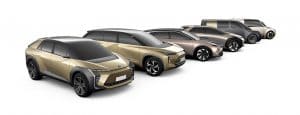
A Volvo XC90 rolls down the assembly line at the maker’s plant in Daqing, China. Sales in China are predicted to be flat in 2020 by government officials.
Chinese government officials are offering a slightly rosier outlook for the country’s 2020 automotive sales, expecting them to come in at about the same number – about 25 million – this year as they did in 2019.
China’s Industry Minister Miao Wei offered the forecast during a recent press conference, according to Reuters. Earlier this month, the China Association of Automobile Manufacturers (CAAM) predicted a 2% decline for 2020. Sales have dropped each the previous two years.
Once the world’s hottest automotive market, China’s new vehicle sales have been in a steady decline for the last year and half, including an 8.2% decline in 2019 The country’s sales have declined for 18 straight months, including the narrow loss in December of just 0.1%, CAAM officials noted. Sales fell 3% in 2018.
(New vehicle sales in China fall 8.2 percent in 2019)
Miao added the ministry is studying postponing the reduction of subsidies for new energy vehicles (NEV). Earlier this month, the ministry said it would not make significant cuts to NEV subsidies this year.
Prior to Miao’s announcement, NEV sales were predicted to be flat as no new subsidies are coming down from the central government anytime soon. Officials are now warning that sales in China are in a “low-growth” phase.
“We have moved away from the high-speed development stage. We have to accept the reality of low-speed development,” Shi Jianhua, a senior official at CAAM, told a news briefing. “We had high-speed growth for a consecutive 28 years, which was really not bad, so I hope everyone can calmly look at the market.”
(November auto sales slump 5.4% in China)
However, this runs counter to the central government’s aggressive plans for NEVs. China has become the largest market for plug-based vehicles, and demand could ramp up even more rapidly if government regulators follow through on a proposal that would call for 25% of the new vehicles sold there in 2025 to be electrified.
The NEV regulations that were formally enacted in late 2017 quickly set off a battery-car boom, sales in China topping the 1 million mark for the first time in 2018. Demand remained solid through the middle of this year but then came unplugged when consumer subsidies were cut back.
The overall Chinese market slumped this year, but the EV market took an even sharper plunge, down 46% for the year-to-date when compared to the same period in 2018. A clearer indicator: Plug-in vehicles, including both PHEVs and pure battery-electric vehicles, or BEVs, slipped to just 3.5% of all Chinese new vehicle sales in October compared to 5.5% for the first 10 months of the year combined.
(China set to raise EV target to 25% of new car sales – can Tesla, other foreign carmakers benefit?)
The subsidy cuts have hit hard those Chinese domestic brands providing relatively affordable, albeit low-range, EVs. On the other hand, sales of expensive, high-end EVs continue to thrive, helping foreign OEMs to increase market share, now up to 14 percent.


